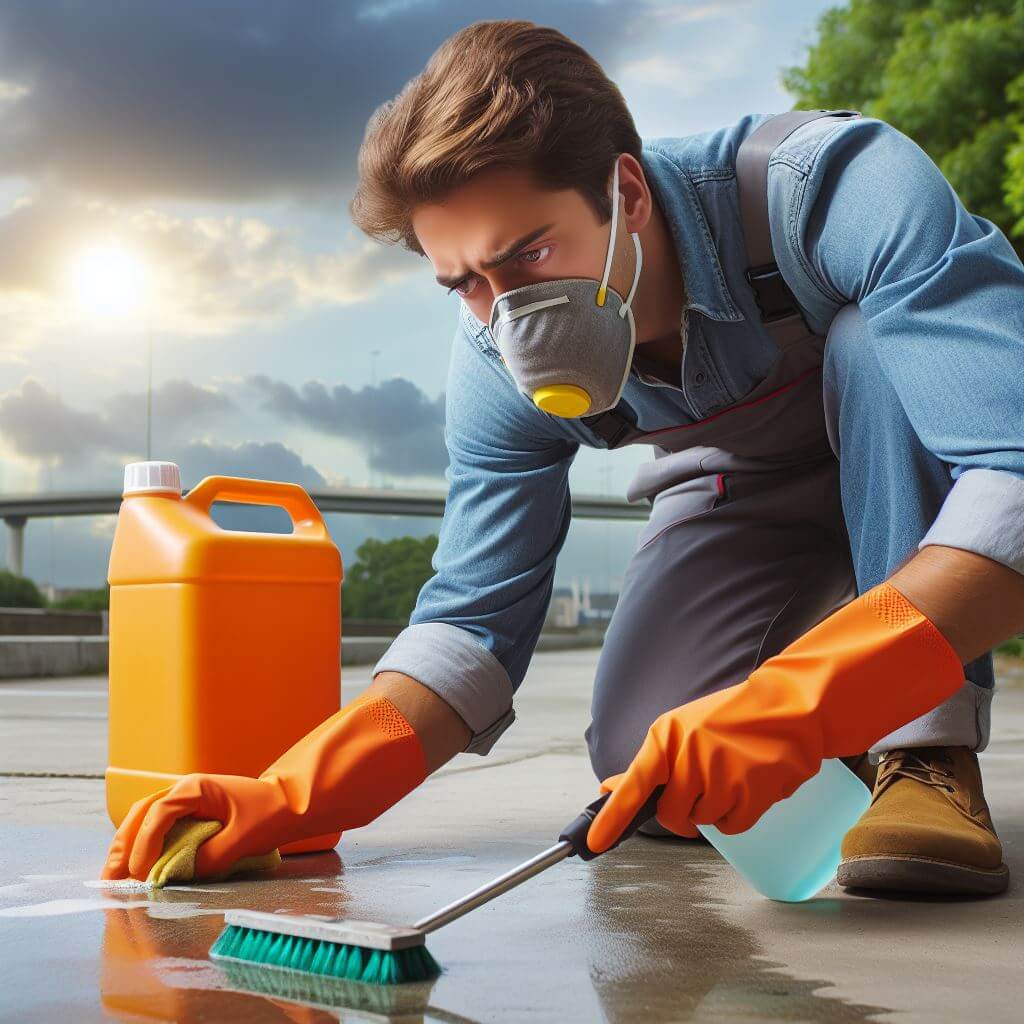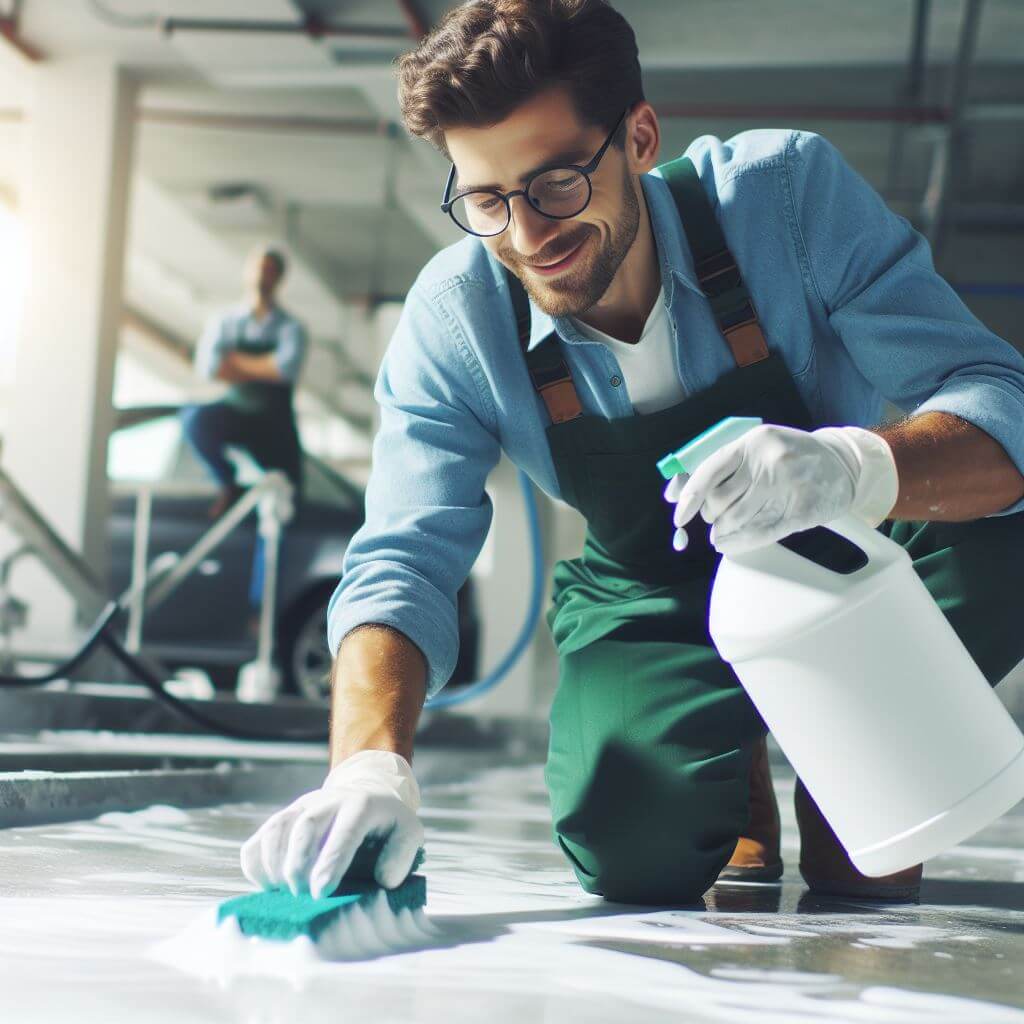- Home
- Natural Cleaning Agents
- Muriatic Acid to Clean Concrete
Can You Use Muriatic Acid to Clean Concrete? Unveiling the Truth
When it comes to maintaining the look and durability of your concrete flooring, finding the right concrete cleaner is crucial. Among the various options, muriatic acid often emerges as a powerful contender. But, the question remains: is it safe and effective for your concrete surfaces? Let's dive into the facts and uncover the truth behind using muriatic acid for cleaning concrete.
Muriatic acid, a strong chemical, is known for its ability to tackle tough stains and restore concrete to its original glory. However, its strength also brings risks that require careful consideration. By understanding both the benefits and the precautions, you can make an informed decision on whether muriatic acid is the right choice for your concrete cleaning needs.
Understanding the Power of Muriatic Acid in Concrete Cleaning

Muriatic acid excels at removing stubborn oil stains and rust stains from concrete, showcasing its potency as a cleaner. Its effectiveness is unparalleled, especially when compared to other cleaning agents like oxalic acid.
1. The Essence of Muriatic Acid in Concrete Maintenance
For those battling persistent oil stains and rust stains, muriatic acid offers a powerful solution. Its use extends beyond cleaning, playing a crucial role in the overall maintenance of concrete surfaces by effectively dealing with these common issues.
What Does Muriatic Acid Do to Concrete?
When muriatic acid is applied to concrete, it reacts with the surface to dissolve unwanted materials. This includes breaking down oil stains and rust stains, which are particularly challenging to remove through other means. The acid’s strong reaction helps in thoroughly cleaning the surface, revealing a cleaner, more uniform appearance
2. The Risks Involved in Using Muriatic Acid
While muriatic acid is effective, it's not without its risks. Its potent nature can cause damage to the concrete surface if not used correctly. Additionally, the acid's strength means it must be handled with care, especially when used to etch the concrete.
Safety Measures for Handling Muriatic Acid
Due to the risks associated with its use, handling muriatic acid requires strict safety measures. Protecting yourself from its harmful effects is crucial, particularly when addressing oil stains and rust stains. Personal protective equipment is essential to prevent any harm while using this powerful cleaning agent.
Step-by-Step Guide on Using Muriatic Acid for Concrete

Using muriatic acid for concrete involves a detailed process, from preparing the surface to the final cleaning step. This includes addressing oil stains, rust stains, and ensuring the right mixing ratios. A garden hose, for example, is vital for rinsing, and understanding how to etch concrete correctly is key to successful cleaning with muriatic acid. The goal is to achieve a clean, yellow color-free surface using a dilution of 1 part acid to 4 parts water.
1. Preparing Your Concrete for Muriatic Acid Cleaning
Before applying muriatic acid, it's important to tackle any rust stains on the concrete. Ensuring the surface is clean and ready for the acid helps in achieving the best cleaning results.
Equipment and Safety Gear Needed
To safely use muriatic acid, you’ll need protective gear such as gloves, goggles, and a mask. Additionally, a plastic bucket for mixing the acid, a stiff brush for scrubbing, and a garden hose for rinsing are essential tools for the job.
2. The Process of Applying Muriatic Acid
Applying muriatic acid requires careful attention, especially when dealing with rust stains. The correct technique and safety precautions are paramount for effective cleaning.
Mixing Ratios and Application Techniques
The ideal mixing ratio for muriatic acid cleaning is 1 part acid to 4 parts water. Applying the solution with a sprayer or brush and allowing it to react for a few minutes before rinsing thoroughly ensures a deep clean.
3. Neutralizing and Rinsing After Acid Etching
After using muriatic acid, it's important to neutralize the concrete surface to stop the acid's reaction. This step is crucial for both the concrete surface and the flooring’s longevity.
Ensuring a Safe and Effective Cleanup
Post-acid etching, a thorough rinse with water is essential. Neutralizing any remaining acid with a baking soda solution ensures a safe and effective cleanup, preserving your concrete’s appearance and integrity.
Evaluating the Outcome and Aftercare

Cleaning concrete with muriatic acid can yield impressive results, restoring its appearance significantly. Understanding what to expect and how to care for your concrete afterward is key to maintaining its condition over time.
1. What to Expect After Cleaning Concrete with Muriatic Acid
After cleaning concrete with muriatic acid, you can expect a noticeable improvement in its appearance. The surface will be free from tough stains, revealing a cleaner and more uniform look. However, proper aftercare is essential to ensure the longevity of the cleaning results.
The Visual and Structural Impact
After cleaning concrete floors with muriatic acid, you'll notice a significant change. Visually, the surface will look brighter and more uniform, revealing the natural beauty of the concrete. Structurally, the acid etching process creates a texture that improves the floor's grip, reducing slipperiness. This process, however, requires precision; too much acid can damage the concrete, leading to a rough and uneven surface. It's crucial to follow guidelines closely to achieve the desired outcome without compromising the integrity of your concrete floors.
2. Long-Term Care for Acid-Etched Concrete Surfaces
To ensure the longevity of your acid-etched concrete floors, regular maintenance is key. This involves routine cleaning with gentle, pH-neutral cleaners to preserve the surface's integrity and appearance.
Maintenance Tips to Preserve Your Clean Concrete
For long-lasting beauty and durability of your concrete flooring, adopt a proactive maintenance routine. Begin by regularly sweeping or vacuuming to remove dirt and grit that can wear down the surface. For deeper cleaning, use a mild detergent solution, avoiding harsh chemicals that can damage the etched surface.
Additionally, applying a concrete sealer every few years can protect against stains and moisture, keeping your concrete flooring looking as good as new. Remember, the effort you put into maintaining your concrete floors will directly reflect in their appearance and lifespan.
The Final Verdict on Using Muriatic Acid for Cleaning Concrete
Using muriatic acid to clean your concrete can be a powerful method, especially when dealing with tough stains like mold and mildew. However, this highly corrosive hydrochloric acid solution requires you to take serious precautions.
Personal protective gear, including rubber gloves, rubber boots, and protective clothing, is non-negotiable to ensure your safety. The process involves diluting concentrated muriatic acid with water, specifically pouring water into a plastic bucket first and then adding the acid slowly to prevent a dangerous chemical reaction.
While muriatic acid effectively cleans deep into the concrete, removing unwanted concrete stains and preparing concrete floors for proper adhesion of acrylic or penetrating sealers, it's important to remember that muriatic acid may damage plant life around your concrete driveway or swimming pool area.
After using muriatic acid, neutralizing the area with garden lime or a similar substance is crucial to restore pH levels and prevent any permanent damage. Ultimately, when used carefully and responsibly, muriatic acid can be an effective cleaning solution for your concrete surfaces, but always weigh the risks and ensure you're prepared for the task.
You may also like to know if you can put muriatic acid down the drain